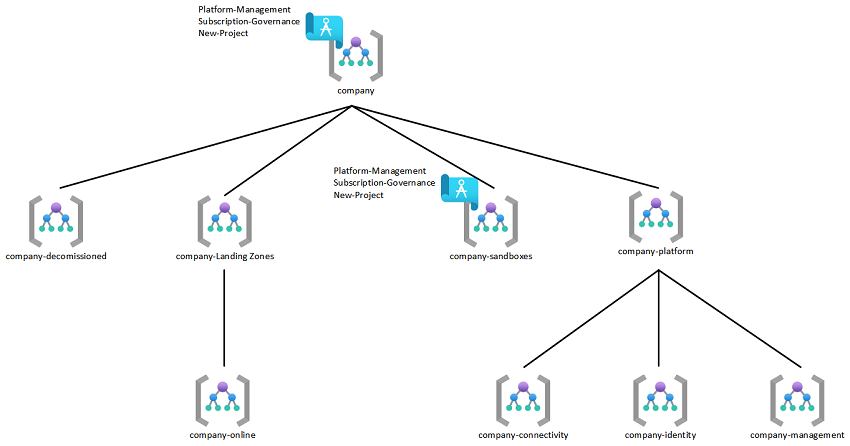This repo contains pre-built Blueprints and Azure DevOps Pipelines to streamline the deployment of a well-governed Azure environment. This repo builds off the work of the Cloud Adoption Framework and Enterprise Scale architectures.
The deployment of Enterprise Scale into your environment creates a management group structure and custom policy scoped to the top level management group. A depiction of this hierarchy can be found below.
This repo contains a set of Azure Blueprints that will be provisioned via pipeline and scoped to the top level management group (prod) and the "Sandbox" (dev) management group Enterprise Scale builds.
-
This blueprint is used to establish the landing zone for the platform management subscription. It is recommended to set the Blueprint assignment to "read-only" in order to prevent modification of the resources created by this Blueprint.
-
The following items are deployed as part of this Blueprint:
- User Assigned Managed Identity
- Storage Account
- Log Analytics Workspace (365 Day Retention)
- Azure Sentinel
- Key Vault
-
This blueprint is used to establish base governance for an Azure subscription. It is recommended to set the Blueprint assignment to "read-only" in order to prevent modification of the resources and policies created by this Blueprint.
-
The following items are deployed as part of this Blueprint:
-
Centralize Activity Logging to Platform-Management Workspace
-
Allowed Locations for Resources (East US 2/Central US)
-
Allowed Locations for Resource Groups (East US 2/Central US)
-
Audit Virtual Machines with Pending Reboot
-
Audit if budgets do not exist in subscriptions and resource groups
-
Enable Azure Security Center (Standard/Free) and Centralize to Platform-Management Workspace
-
Enable Azure Security Policy
-
Deploy Network Watcher for New Networks
-
Deny IP Forwarding on Virtual Machine NIC's
-
Deny 'Basic' VPN Gateway
-
Deny Creation of PaaS Services Without Network ACL:
- Azure Kubernetes Service
- CosmosDB
- Key Vault
- MariaDB
- MySQL
- PostgreSql
- SQL DB
- Azure Storage
-
Audit Service Endpoints for Resources:
- Azure Container Registry
- App Service
- Event Hub
- Service Bus
-
Enable Base Set of Azure Subscription Alerting
- IAM Changes
- NSG Modification
- Policy Assignment Deletion
- Public IP Creation
- Resource Group Creation
- Route Table Modification
- VNet Modification
-
Enable Base Tagging Policy
- Deny Resource Group Creation Without Tags
- Inherit Tags on Resources from Resource Group
- Application Name
- Application Owner
- Business Criticality
- Contact Email
- Cost Center
- Data Classification
-
Allowed VM SKU's
VM SKU CPU MEMORY (GB) USE Standard_B1ms 1 2 Burstable/Test Standard_F2s_v2 2 4 Production Standard_B2s 2 4 Burstable/Test Standard_B2ms 2 8 Burstable/Test Standard_D2s_v4 2 8 Production Standard_B4ms 4 16 Burstable/Test Standard_D4s_v4 4 16 Production Standard_F8s_v2 8 16 Production Standard_B8ms 8 32 Burstable/Test Standard_D8s_v4 8 32 Production Standard_E8s_v3 8 64 Production Standard_F16s_v2 16 32 Production Standard_E16s_v3 16 128 Production
-
- This blueprint is used to establish the landing zone for new projects. It is recommended to set the Blueprint assignment to "read-only" in order to prevent modification of the resources created by this Blueprint.
- The following items are deployed as part of this Blueprint:
- Resource Group with Required Tags
- Application Name
- Application Owner
- Business Criticality: Allowed Values (Tier0, Tier1, Tier2, Tier3)
- Contact Email
- Cost Center
- Data Classification Allowed Values (Public, Internal, Restricted, Confidential)
- RBAC Role (Single user or group scoped to the Resource Group above with 1 of the following roles)
- Contributor
- Virtual Machine Contributor
- Storage Account Contributor
- Network Contributor
- Key Vault Contributor
- SQL DB Contributor
- Budget Alert to Contact Email of Resource Group
- Alerts at 80% of monthly spend
- Resource Group with Required Tags
Each Blueprint has a set of Azure DevOps YAML pipelines that can be imported to jump start infrastructure as code deployments. There are a handful of custom Pester tests that run against the Blueprints to highlight how infrastructure deployments can be aligned to defined specifications and test procedures.
-
Deploy the management group scafolding structure as per image above
-
Create a service principal in Azure to be used for pipeline deployments
-
Assign the service principal to the top level management group -created in prior step- with "Contributor" permissions
-
Create a new Azure DevOps (ADO) project
-
If you do not have an existing ADO environment this can be done for free here.
-
-
Import this repo into your new ADO project
-
In your ADO project settings, create a service connection with the service principal created in a prior step
-
Import the ADO pipelines from each Blueprint pipeline folder
-
In ADO, create a branch protection policy on main (prod)
-
Clone the ADO repo to your local machine and use your preferred IDE, in this case is Visual Studio Code (VSC)
-
In VSC, create a new branch named "variable-update" (or any name you prefer)
-
Search the Blueprints folder in your local repo and replace the following
- <yourConnectionName> = Your ADO service connection name
- <yourProdSuborMgtGroup> = Your top level management group
- <yourDevSuborMgtGroup> = Your sandbox management group
-
Save, commit, and push
-
Validate all pipelines run to success and a .1 version of the Blueprint published at the sandbox scope
-
Test Blueprint assignment in sandbox subscription(s)
- Assign Platform-Management to central logging subscription
- Assign Subscription-Governance to all subscriptions
- Assign New-Project to create a resource group for any new workload
-
Once satisfied issue a pull request (PR) to merge changes into main
-
Verify all pipelines run to success and a .1 version of the Blueprint is published at the top level management group


